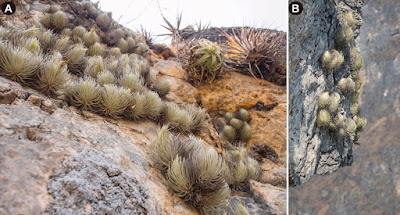 |
| Viridantha uniflora Hern.-Cárdenas, Espejo & López-Ferr.
in Hernández-Cárdenas, Díaz, López-Ferrari & Espejo-Serna, 2019.
|
Abstract
Based on morphological evidence, we propose to raise Tillandsia mauryana forma secundifolia to species level with the name Viridantha secundifolia (Ehlers) Hern.-Cárdenas, Espejo & López-Ferr. Viridantha secundifolia can be readily distinguished by the falciform rosettes, the broadly oblong to square, 1–1.2 × 0.8–1.1 cm leaf sheaths and by the 1.8–2 × 0.7–1.2 cm floral bracts. Additionally, we describe and illustrate Viridantha uniflora Hern.-Cárdenas, Espejo & López-Ferr., from the state of Oaxaca, Mexico. The new species is morphologically similar to Viridantha boqueronensis, but differs by the nearly square leaf sheaths, 1.3–1.5 × 0.4–0.5 cm spikes and by the presence of only one flower per spike. A key to the taxa, morphological descriptions, list of specimens examined, illustrations and a distribution map of the described taxa are included.
Keywords: Hidalgo, México, Oaxaca, Tillandsia, Viridantha
Viridantha uniflora Hern.-Cárdenas, Espejo & López-Ferr., sp. nov.
Diagnosis: Viridantha uniflora is similar to V. boqueronensis but differs in the shape (square vs. ovate to triangular) and the width of the leaf sheath (0.7–0.8 cm vs. 1 cm); the width (0.4–0.5 cm vs. 0.7–1.3 cm) of the spikes, the number of flowers per spike (always 1 vs. 2–5); and in the shape of the floral bract (ovate vs. elliptic).
...
Habitat and ecology: Viridantha uniflora is only known from the boquerón of the Santos Reyes Tepejillo municipality, located in the Sierra Madre del Sur in the northwest region of the state of Oaxaca, where it grows on vertical walls in dry oak forests and tropical deciduous forests. The plants of V. uniflora grow in colonies, between 1700 and 1900 m a.s.l., on the cliffs of the boquerón amongst other saxicolous herbs. (Figs 2, 3).
Phenology: The plants of Viridantha uniflora bloom in April and May.
Etymology: The specific epithet refers to the presence of one flower per spike, condition only known in the proposed taxon.
Viridantha secundifolia (Ehlers) Hern.-Cárdenas, Espejo & López-Ferr., comb. et, stat. nov.
Basionym: Tillandsia mauryana L.B. Sm. forma secundifolia Ehlers,
Die Bromelie. Sonderheft 6: 56–60. Figs pp. 56, 57, 60. 2009.
Die Bromelie. Sonderheft 6: 56–60. Figs pp. 56, 57, 60. 2009.
Habitat and ecology: Viridantha secundifolia is only known from the state of Hidalgo in the western and eastern regions of Metztitlán and Tolantongo municipalities, respectively, where it grows on vertical walls in xerophilous scrubs at elevations between 1100 and 1900 m a.s.l. (Figs 1, 2).
Rodrigo Alejandro Hernández-Cárdenas, Alejandra Serrato Díaz, Ana Rosa López-Ferrari and Adolfo Espejo-Serna. 2019. Novelties in the Genus Viridantha Espejo (Tillandsioideae, Bromeliaceae). PhytoKeys. 132: 99-110. DOI: 10.3897/phytokeys.132.36959
Resumen: Con base en evidencia morfológica, proponemos elevar a nivel de especie a Tillandsia mauryana forma secundifolia con el nombre Viridantha secundifolia (Ehlers) Hern.-Cárdenas, Espejo & López-Ferr. Viridantha secundifolia puede distinguirse fácilmente por las rosetas falciformes, las vainas foliares ampliamente oblongas a cuadradas, de 1–1.2 × 0.8–1.1 cm y por las brácteas florales de 1.8–2 × 0.7–1.2 cm. Además, se describe e ilustra Viridantha uniflora Hern.-Cárdenas, Espejo & López-Ferr., del estado de Oaxaca, México. La nueva especie es morfológicamente similar a Viridantha boqueronensis pero difiere por las vainas foliares cuadradas, la espigas de 1.3–1.5 × 0.4–0.5 cm y por presentar una sola flor por espiga. Se proporciona una clave de identificación, descripciones morfológicas, lista de ejemplares examinados, ilustraciones y un mapa de distribución de los taxa descritos.





